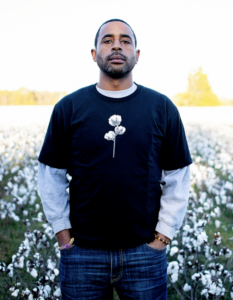
Farmers name: Julius Tillery
Acreage: 125
Location: Rich Square, NC
Method of Access: Ownership
Year Founded: Six generations, early 1900s
Affordability Tools: Purchase
Farm Operation: Cotton, mushrooms, hunting
“Cotton is our culture; let’s grow together.”
Julius Tillery is a fifth-generation farmer on family-owned and operated land. Tillery Farms is located in Rich Square, North Carolina, in the Black Belt region. This region spans from Alabama into the Carolinas and was once known for its rich soils primed for growing cotton. The land was originally acquired by Julius’s great-great-grandfather, Reverend D.L. Tillery, early in the 20th century. Julius, along with his father, grandfather, and relatives manage their growing operation which consists of rotating crop production, hunting, and of course—cotton. While his father is the lead agronomist in the farm operation, Julius leads the marketing side and spearheads the farm-fashion venture, Black Cotton, creating genuine and distinguished home décor, jewelry, and accessories hand-made with cotton cultivated from their farm.
When asked what led to diversifying his family farm operations, Julius explained:
“We are old-school farmers; we have to get it piece-by-piece and build up to be able to survive on the land. I was prepared to do it the old school, acquiring debt to make money, like my dad and grandfather might have had to, but to keep the farm stable I have to do something innovative and unique.”
Apart from growing cotton, Tillery Farms rotates crops throughout the year, including soybeans, and sells through conventional channels in the areas. “We are a modern farm, but we aren’t a precision agriculture operation yet,” Julius says, noting that they have not begun the use of advanced on-farm technology. Before starting Black Cotton, Julius explored other new opportunities in vegetable and mushroom production, noting higher premiums per pound, but those enterprises proved to be labor intensive. “I just started looking around and realized people don’t know about cotton, and the concept started growing. The textile business was a bit difficult to get into and can be expensive, so I started with home decor and then clothing.”
“We only farm what we own.”— Julius Tillery
Tillery Farms is a family affair. The family land is considered heirs’ property, overseen by his father and his three sisters. Heirs’ property is passed down by inheritance, usually by someone without a will or an estate plan. In Julius’s family, as family members decided to sell or wish to move on, other family members have purchased their shares.
“To be honest, I like holding our land as heirs’ property because it’s not easy for someone to scheme up on the land—it’s tied up. Me and my family are all together and understand our roles. But every family isn’t like that. Working in advocacy, I’ve seen people lose land, and the number one reason is no one is working on the land or intimate with the land. If you want to keep your land, be on it—do something with the land. Long distance, paying money on it is not good because somebody is not going to care. As long as me and my dad go out and farm and pay the taxes, my family is good. When people try to sell or don’t want to pay debts, that’s when heirs’ property becomes an issue.”
The issue of whether to hold land as heirs’ property is a deeply nuanced one that is a unique decision for each family. The state law relevant to heirs’ property is different, depending on where the land is located. When managing heirs’ property, it is best practice to communicate the goals for the land with close family members and seek legal advice on methods to protect land and assets.
Eyes to the Future
Julius is a passionate advocate, farmer, teacher, and entrepreneur with a vision for the bright future not just for his own businesses, but for other Black farmers also.
Black farmers continue to face barriers to capital, high-value markets, and access to connections that can bring in more support and awareness. But despite these barriers, Mr. Tillery describes the opportunities to create virtual and physical marketplaces to develop authentic brands and products that farmers can grow specific to their story. Also, as urban agricultural movements grow in cities, he notes a trend of more Black people finding opportunities to connect with land either personally or joining emerging professions to provide more direct sourcing from local growers, starting innovative food businesses like food trucks. These outlets are allowing local farmers to see high premiums and develop closer relationships between rural growers and partners in urban areas.
He offered the example of the Black Farmer’s Market, seasonally held near Durham, North Carolina, which offers a large marketplace for Black growers, food businesses, and makers.
More places like the Black Farmers’ Market creates spaces for black farmers to work efficiently together and keep money flowing in our economy. We pay for convenience at big-box stores, but are those the people we want to pay? The more awareness about who we are and how to support our goods and resources, the better we will be in the future.
Tillery Farms will continue to grow, and the Black Cotton brand is a culmination of hard yet rewarding work. “Getting clothes made from our cotton, specifically for a brand inspired by our cotton, is a monumental achievement. Now it’s time to grow and sustain,” said Julius.
Julius proclaims himself to be one of the originators of putting pride back into Black farming and seeks to uplift his legacy and the traditions of Black farmers with integrity. As for his family land, he hopes good relationships continue, “I hope my family can keep peace, love, and sacrifice for each other. If this doesn’t work out, I may move on to Black Corn or Black Peanuts because one thing is for sure—I’m not going to give up on my family, and I’ll keep working until the end.”
This case study authored by Renee Smith-Nickelson MFALP ’18.
